One of these days I'd like to put some of my old DOS programs on the web to make them a bit more accessible. I used to think that I would do that in Java but these days Flash seems to be the most popular way to do interactive thingies on the web so maybe I should learn that. Or even just plain old HTML with Javascript - if someone can implement Lemmings in DHTML then I'm sure Cool Dude and probably some of the VGA demos could probably be implemented that way as well.
Archive for the ‘games’ Category
Webifying old games
Tuesday, August 5th, 2008Digger adventure
Monday, August 4th, 2008Lately I haven't really had any interest in improving Digger, but I still occasionally think it might be fun to write a sequel. "Digger 2" or "Digger's Adventure" would have a 2D continuously scrolling playfield, impenetrable walls, new monsters, bosses, new items to collect, more weapons, shields, warps, speed-boosters, and maybe the possibility to dig to the surface where it would be possible to jump.
Another 2D game
Sunday, August 3rd, 2008Another 2D game I'd like to write (which might even be the same game as that one) is a bouncing ball game.
The player would be in control of a ball which could be accelerated by means of the direction keys. So holding down right would give a velocity increase in the positive x direction proportional to the length of time the key was held down (there have been a few games that work like this but in my experience in most non-simulation games the player only has one or two speeds and acceleration to/from these is instanteous). Wind resistance would be implemented to avoid the possibility of the ball reaching unlimited speeds.
Once the player has got used to these controls the next complication is maze traversal. While you could in principle just maneuvre around the maze slowly, it is much more fun to play at speeds close to the ball's terminal velocity. At these speeds, the ball's turning radius will be much larger than the scale of features in the maze, so the ball will hit the walls. When it does so, the obvious thing to happen is that it should bounce off (unless the wall is dangerous or special in some way).
Another possible complication is areas of the maze with gravity fields. The strength of the gravity could be smaller than the control acceleration (in which case it just changes the controls a bit) or could be greater (in which case entire directions become impossible to travel in). Gravity fields can be constant or central (or may have even more complicated configurations).
Then there could be places in the maze where the drag factor is proportional to some the velocity plus some constant field (i.e. windy places).
Some parts of the maze could be flooded with various different kinds of fluid, giving the opportunity to show off fun 2D fluid dynamics simulations.
Then of course there are the usual game elements - things to collect, power ups, space warps, spikes, enemies with various degrees of artificial intelligence and so on.
2D game
Tuesday, May 20th, 2008I don't tend to have time to play many computer games these days (though I made exceptions for Portal and Lost:Via Domus), but I still like to keep abreast of how technology trends change in games.
A concept that I think is interesting in games is to "raise the stakes" as the game progresses, so that later levels seem to be more important than earlier ones. A couple of contemporary games (neither of which I have played) that embody this principle are Katamari Damacy and Spore. As the game progresses, the very scale of the action increases, causing the early parts of the game to pale in comparison.
3D graphics have become much more impressive in the past few years but the trouble with 3D is that the extra degrees of freedom make the controls more complicated and difficult to learn (especially for people who don't play many 3D games).
I think it would be interesting to apply the "increasing scale" concept to a 2D game using modern graphical techniques. My idea is a 2D-scrolling shoot-em-up. You start off with a very small, simple "asteroids" spaceship with a very simple weapon. As you blow things up, you can collect more weapons which make your spaceship bigger. Using these bigger weapons, you can attack bigger and bigger targets. The view gradually "zooms out" as the size of the ship, weapons and targets increases.
This idea also reminds me of the Seven Force in Gunstar Heroes on the Megadrive. Easy parts of this boss appeared in an early level and then in a later level there was a "scaled out" version which was much harder and with smaller sprites.
And with modern technology, 2D games can be seriously beautiful. Aquaria does actually zoom in and out a bit, but not by orders of magnitude as I'm imagining.
Cool stuff you can't find on the web
Saturday, November 3rd, 2007Every so often, I think of something - perhaps a book, television programme or computer game - that I remember but that I have lost or have no record of. Usually when that happens, I turn to the web - a simple search and I have a massive amount of information on whatever it is in no time.
However, sometimes it doesn't work. For whatever reason, the collective consciousness has failed to remember some things. A few of these are recorded here, but since I'm relying on my memory, some facts may be inaccurate.
Fire was a computer game I used to have a copy of, but it was destroyed by the Dir II virus. You had to fly a helicopter through 8 levels, blowing up various things including hot air balloons, planes and a train (which constituted level 2). Then there were some levels over water, where you had to destroy boats, and some over desert, where you had destroy tanks and ground-to-air missile launchers. The really amazing thing about this game was the parallax scrolling - I'd never seen anything like it on the 8MHz 8086 I played it on. It had CGA and EGA graphics modes. The title screen (which took up most of the first of the two 360K floppy disks the game came on) was beautifully atmospheric, with the helicopter flying in front of the sun and stopping in the middle. Then there was this brilliant (and long) bit of sampled soundtrack. There was some documentation, but it was in French. When I asked Jim Leonard of Mobygames, he hadn't heard of it but said it sounded like a game by Loriciels. I found some screenshots for another Loriciels game on the web and the graphics did have a similar sort of style. I'd really like to play this again, but searching for "Fire" in the context of computer games is a somewhat futile exercise.
[Update!] - Fire wasn't by Loriciels at all but by New Deal Productions. I have found information about versions for the Amstrad CPC, Amiga and Atari ST, but still haven't found the PC version.
[Update!] - Found it! (at ibm5150.net). It can run from a hard drive in theory but the contents of the zip file need to be in the root directory for it to work. I seem to recall that to run it from 2 360Kb disks, the CGA and EGA directories need to be on disk 2 and everything else on disk 1. Start with "fire c" for CGA graphics, "fire e" for EGA graphics or "fire h" for Hercules graphics. The documentation also mentions "fire v" but that doesn't seem to work. This is probably because there's no vga graphics directory (it was also missing on the copy I had on floppies). The sampled soundtrack 52.7 seconds of 4-bit samples at 9.322KHz (1/384 of the NTSC colour burst frequency). DOSBox plays it fine in all 3 graphics modes, though needs to be slowed down a bit from the default - the game is CPU-speed dependent (unusually for a game made as recently as 1989).
For the most part the game is of very high quality but there are a few rough edges - apart from the VGA graphics problem already mentioned, the game seems too difficult to start with and then very easy once you get the knack of it. This, combined with its rarity, makes me wonder if the PC conversion was unfinished or unreleased.
I used to have a book which (like the "choose your own adventure" series) was divided up into sections, between about 1 and 5 per page. At the end of most of the sections there was a decision to make, with a section number for each choice. There were about 200 sections altogether, and many possible paths through the book. Every time I read it I came across sections I hadn't seen before. The book was also a competition - if you figured out it's secret you had a chance of winning a trip to Disneyland. The plot was that the land was dying, and you had to find a magic word to tell Steeleye the Raven so he could break the spell and restore the land. At one point in the book, you were falling and had to shout "Save me, Steeleye!", holding the feather he gave you at the beginning of the book, in order to get rescued. There were puzzles such as roman numeral codes and liar/truth-teller type things. There was a unicorn near the beginning who gave you a tear which emitted light. There was a talking tree near the end, and there might have been a swarm of bees somewhere. One character says "Deeds, not words" and tries to kill you. The book was published by Ladybird (it was that shape) but I don't remember what it was called or who wrote it.
[Update!] - I now know that the book is called "Steeleye and the lost magic" by Jason Kingsley, illustrated by Jon Davis and pubished in 1987. If anyone can help me find a copy I'd be very grateful to them!
[Update 2!] - I now have a copy of the book! It's a bit shorter than I remembered (only 117 sections) and a bit easier (I've solved it, I think, apart from one cryptic clue) but otherwise very much as I remember. I've scanned it so hopefully soon I'll find time to put it on the web (okay, it would be a copyright infringment, but since the book is out of print I'm sure there would be no harm in it.)
Links which helped me in my quest to find this book:
Demian Katz's Gamebook site - http://www.netaxs.com/~katz/game/book.htm
The Cheesypeas Ladybird book site - http://www.cheesypeas.demon.co.uk/ladybird
Sadly, both of these websites have since gone missing. Please let me know if you find them.
Comedy wordsmith and Splicer's disease sufferer Creighton Wheeler, who used to appear regularly on
Kevin Greening's weekend morning shows on BBC Radio 1, and now appears somewhat less regularly on Steve Wright's afternoon show on Radio 2.
[Update!] - The part of Creighton Wheeler is performed by Andrew McGibbon. Testbed made two shows about Creighton Wheeler in 2003 for Radio 4, called "Wheeler's Wonder" and "Wheeler's Fortune". Anybody know where I can get a hold of these? Apparently Creighton Wheeler has also appeared on Loose Ends.
Pickwick tell-a-tale tapes (in association with Ladybird books, Pickwick international and Moss Music) - brilliant audio books for children. I have "Treasure Island", "Swiss Family Robinson" and "Gulliver's Travels" but I'm sure there were many more. The voice acting and classical music were great.
[Update!] - Reader James pointed me to this website which is selling these tapes.
Along a similar vein, there used to be a magazine (I think) which came with a tape which had various childrens stories on it. The one I remember was "The thin king and the fat cook" but there were a few on each tape. I had a couple of tapes, but I've lost them now. Maybe they are still at my parents' house somewhere.
[Update!] - This is what I was talking about. Apparently I had "Story Teller 2" parts 5 and 16 and possibly also "Christmas Story Teller" part 2, because the titles Bored Brenda, Noggin And the Birds, The Snow Bear, The Inn Of Donkeys, Shorty The Satellite And The Brigadier, The Nightingale, Hugo And the Man Who Stole Colours, Mole's Winter Welcome, The Tale of the Little Pine Tree and Grogre and the Giant Nasher seem familiar. I remember very little about any of these except that (as I recall) some of them made me feel quite sad. And there was something about a picnic of bread, cheese and apples in one of them. And people getting swallowed up by a bog. Derek Jacobi's voice still makes me think of these stories to this day. It's quite possible that at least some of these tapes were chewed up by my tape player - it used to do that every once in a while (particularly when I stuck things into it - I was a little scientist).
[Update!] - I got a hold of a digital copy of all of the tapes and magazines, and they are just as good as I remember - extremely well done. I have been playing them for Alexander but he's a bit young for them at the moment. I look forward to the day when he is old enough to enjoy them. The one with the picnic was "The Snow Bear", and the sad one was "The Nightingale" (all these stories have happy endings, though). "Mole's Winter Welcome" still brings a tear to my eye.
The A Word A Day entry for 18th December 1998 reads:
Date: Fri Dec 18 00:04:27 EST 1998
Subject: A.Word.A.Day--straight-from-the-shoulder
X-Bonus: We see but dimly through the mists and vapors; \
Amid these earthly damps \ What seem to us but sad, funeral tapers \
May be heaven's distant lamps. -Longfellow (1819-1892)
straight-from-the-shoulder (strayt-fruhm-thuh-SHOAL-duhr) adjective
Frank and forthright: straight-from-the-shoulder reporting.
"A striking poem called Sequinned ends this way:
Girl, don't you let that city get away.
Lift it up, raise it up, slip your arms through
and take it back to dance.
This is poetry that speaks to us boldly, straight from the shoulder."
Natalie Soto, et al., On the Shelf, Rocky Mountain News, 21 Dec 1997.
This week's theme: idioms.
Anyone know who this poem is by and where I can get a copy?
[Update!] My friend Claudine Burgos found the poem. Not on the web, though - by the old-fashioned technique of looking up the archives of the Rocky Mountain News and calling the library to find a copy. The poem is by Allison Adele Hedge Coke and goes:
Don't tell me you couldn't reach down pick up
the whole gleaming garment and wear it
to fancy shawl dance back home. Dancing proud
in a twenty -four- dollar trinket city.
All laid out
shimmering and shining on jet black world
traffic lights, stret lamps, hot neons, cool fluorescents.
Headlights
swim freeways electric
minnows, glittering eyelets on bridges
bridges lacing up New York and Newark, separate
sides of a sequined vest. Borough lights trace out
webbed wing
butterfly design, no wasps- mosquitoes even.
Something ready to fly off the whole metro stretch.
Some cousin calling:
Girl, leave your French braids right `cause
Cut Nose is goin' ta have it out with you
Over snagging her sometimes half-side last night.
She wants to take yoru prize and crown
from Red Nations Pow Wow-
Her eyes painted sharp red at the corners,
red as the landing light
on this plane's wing tip.
Her plume high and straight, the Empire State,
while yours falls
gently over your part. But that vest-
red, green, gold, silver sparkles,
no one's got more brilliance.
More elegant that bugle beads and embroidery,
More stunning than satin and silk.
Girl, don't you let that city get away,
Lift it up, raise it, slip your arms through
And take it back to dance.
The game Willy the Worm was written by a guy called Alan Farmer. Anyone know anything about this game other than what's in the documentation, such as where to obtain the editor, and what the author is doing these days? I'd be particularly interested to know if there was ever a "Willy the Worm II" or a "Pete the Pigeon" game.
[Update!] - A school friend of Alan's sent me some of his software:
- Willy the Worm II and the level editor for Willy the Worm I.
- A DOS shell called The Compleat Filer (sic).
- A Spacewar clone called Rocket Rangers.
- An implementation of Conway's The Game of Life.
I used to have a book called something like "20 Games for the BBC Micro". They were written in BBC BASIC mostly (although there was one - a board game - which was written partly in assembler). You had to type them in. The games included Hunchback, Monty Mole, a Star Wars game and some others I don't remember. How come you can't find downloadable copies of these games to run on an emulator?
[Update!] I since found out what happened to the book - I lent it to a friend of mine and forgot about it. I'll have to try to remember to get it from him next time I see him, and possibly reproduce some of the programs here.
Chris Evans used to do the breakfast show on BBC Radio 1, and every Friday he and his cohorts would sing "The Weekend Song" (or, possibly, "The Friday Song".) Some of the lyrics were "I want Spielberg to focus my camera / I want Versace to dress my dog...".
[Update!] - Someone sent me some more lyrics:
I want to live in a castle,
I want an ocean for a pond,
I want a jumbo jet just to get to work,
Because it always takes me far too long.
I want to skip in the sunshine,
I want to dive into the deep blue sea,
I want to buy an ice cream for the man in the moon,
Because he always shines his light on me.
I want Spielberg to focus my camera,
I want Versace to dress my dog,
I want a current account at the Jodrell Bank,
I want Niagara falls to flush out my bog.
We're all just a drop in the ocean,
And the world's just the size of a pea,
And like a meal for one, it'll soon be gone,
And it's all just a cliché for me.
Anyone got a recording?
"Das Verflixte Hundespiel" by Artus Puzzle. You had nine cardboard squares, and on the side of each square was half a dog (either a head or a tail). There were four different types of dog. You had to arrange the squares into a 3x3 matrix in such a way that the heads and tails matched up. It was very difficult! There are 9! x 48 = 23,781,703,680 different ways of arranging the squares but only 2 solutions. I eventually gave up and wrote a computer program to solve it.
[Update!] - Das Verflixte Hundespiel is still being sold here. Apparently it is Swiss. This isn't exactly the same version I had - the dog illustations on the version I had were different.
A friend of mine remembers having a British version - anyone know anything about it?
My then girlfriend (now wife)'s family bought me a similar puzzle which is even more difficult as it only has one solution. The box and website claim that there are "over 300,000" wrong ways to assemble the pieces but this is a gross underestimate (probably based on 9! = 362,880 permutations, which doesn't include orientations).
[Update!] - Commenter John requested the solver program and solutions. Here they are. It is currently set up to solve the card suits jigsaw version (I don't have the "Das Verflixte Hundespiel" puzzle to hand). It's not a particularly elegant way of coding it (18 nested loops for the tile choices and orientations) but it should be easy to adapt for similar puzzles. There is a project file for Microsoft Visual Studio .NET 2003 but the code is portable.
This one isn't for me, but for a friend of mine. Dave writes:
Several years ago, a band called Blind Melon did an acoustic set on a late-night ITV rock/metal show called "Noisy Mothers". Around a month later, the lead singer died of a cocaine overdose, after they'd only released two albums [they released a third posthumously]. I've been trying to track down a recording of that ever since I accidentally taped over it a couple of years ago, before I could transfer the VHS to digital... I'll be impressed if anyone in the world can track a copy down...
Can you help?
[Update!] here is one of the songs from the set.
Some years ago, I remember seeing several episodes of a TV show called "They Who Dare" on BBC2. Each episode was only 10 or 15 minutes long (might have been longer or shorter, I don't remember, but I'm sure it wasn't a full half-hour).
Each episode documented some dare-devil sport such as parachuting, hang-gliding or BASE jumping. One particularly memorable episode featured people jumping out an aeroplane and then parachuting down large holes in the ground. The holes themselves were formed by some unusual natural phenomenon, and were quite spectacular even without people parachuting down them.
Each episode was a real work of art - fusing music and beautiful landscape cinematography with the human drama of people who get their kicks from flying through these scenes in some dangerous fashion. It was so enthralling that I remember regularly finding myself realizing at the end of an episode suddenly realizing that I had actually been watching TV for the past 15 minutes and not actually performing these incredible stunts.
I'd love to get a hold of copies of all the episodes of this show, but have only found single, in-passing mention of it using Google.
Along similar lines, I remember hearing about a 5-minute BBC promotional film short featuring a Helicopter tour around the coast of Britain. I never saw it (except for highlights on Points of View but I remember people saying it was really amazing to watch. I have ever since been kicking myself for missing it.
What is this piece of music? I found it on an episode of This American Life but this piece isn't listed. It isn't on TAL's scoring tracks page either (I think - I listened to them all and didn't hear anything that sounded like it). The world needs a search engine where you can upload a piece of music and find out what it is.
[Update!] - Somebody pointed out that such services already exist - Shazam is one and I think there are several others. Unfortunately they all seem to need an SMS-capable mobile phone which doesn't really help me because I don't have one.
[Update 2!] - John Philips from Bath emailed me with the answer - the song is "At The River" by Groove Armada.
This one is a real long-shot, since there is almost nothing to go on.
There is a childrens book I remember reading as a child, but I remember almost nothing about it. I remember that I read it in the childrens' section of Goring library, and it may have been about some children going into space. I think it was (at least mostly) a picture book. I have a vague recollection of one of the illustrations being of something like this (possibly in the middle of a large room, possibly aboard an alien spaceship - though that could just be a mental picture I formed at the time). I don't know that I would even recognize it if I saw it. I do remember that I felt amazingly inspired by it at the time and I have a feeling it may have influenced my life greatly.
I recently visited Goring Library again for the first time in more than 19 years. It was very much like I remembered (though as one would expect it seemed smaller than I had remembered). Unfortunately (with the exception of some Meg, Mog and Owl books I had completely forgotten the existence of) all the books I that were around when I was a child seemed to have been replaced.
So to sum up, this book:
- Was written for children
- Has colour illustrations
- Was published in the UK in 1988 or before
- Has a science-fictiony sort of story, possibly involving aliens
Any suggestions about books that might fit these criteria?
From Ben Davis, via Dave:
Just wondering if anyone remember a game called 'Prunes' for the BBC computer?
I tried searching the Internet the other day, but amazingly the Internet seems to contain absolutely no knowledge of the game's existence. :/
I remember it well enough to remake it last night :) I'm just still getting to grips with the fact that it seems to be completely unknown to the world.
Screenshot: http://bdavis.strangesoft.net/prunes.png
You are "the last of the Giant Prunes", aka the white pixel leaving a cyan trail. You have to surround the "Giant Figs" (red pixels moving randomly and leaving a magenta trail), and then touch a blue-yellow flashing pixel, at which point any fully surrounded magenta regions turn green. Unfortunately there's no win condition (in mine or in the original), so you eventually end up with what resembles a cyan and green world map and nothing to do.
It's a pretty faithful remake. Apart from exact dimensions and timings and stuff like that, the only bits I couldn't remember were the scoring mechanism and the behaviour when a blue helper prune (which eats through fig trails for you) touches a flashing pixel. The sound effects are missing from my version, which is a shame since they had bags of character.
Executables (insert standard disclaimer here yada yada): http://bdavis.strangesoft.net/prunes.exe (DOS) http://bdavis.strangesoft.net/prunes-win.exe (Windows)
Source - compiles with Allegro on some other platforms like Linux and Mac: http://bdavis.strangesoft.net/prunes.cpp
Maybe I'll launch a full-scale investigation to find out who made the original game and make sure they know that they are awesome.
My suspicion is that this was never actually published anywhere - that it was just something coded by a secondary school student over a few lunchtimes (probably starting with the random walk used by the figs and blue things - I coded that up algorithm myself shortly after learning C), evolved into a game and possibly got passed around on disk. It has a Qix-like feel to it so may have been inspired by that. The simple graphics, the fact that it's not winnable and the fact that it's relatively easy to get to a stalemate situation all point to an unpublished, one person job. However, it would be interesting to track down the original version and/or it's author.
Portal
Monday, October 29th, 2007I played through Portal over the weekend. I don't play many computer games any more but I'm glad I made time for this one - very impressive storytelling, and hilarious dialogue (monologue?).
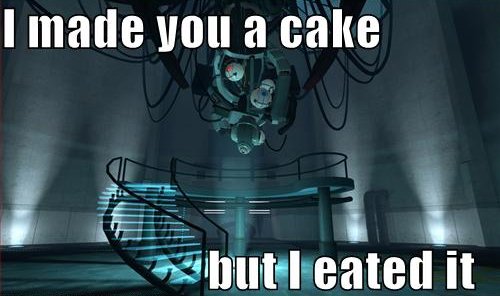
Sand game
Tuesday, January 24th, 2006The falling sand game is an amusing way to while away a few hours. The physics may be distinctly non-realistic but the emergent effects caused by the different interactions between the various substances are fascinating. See if you can figure out how I generated this image:
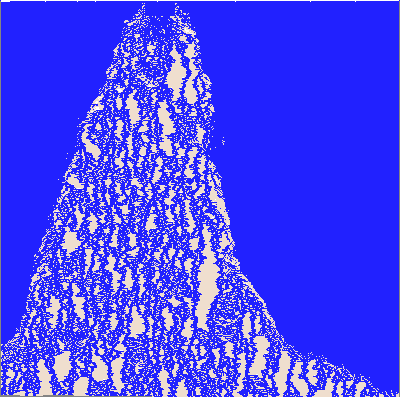
However, the version with flammable zombies is infinitely more disturbing.
Ultima maps
Friday, November 2nd, 2001Warning! You will find major spoilers here if you haven't completed these games yet!
Maps from Ultima VI
Britannian surface

Dungeon level 1
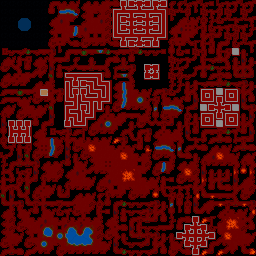
Dungeon level 2
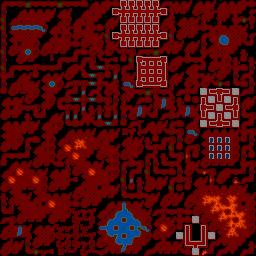
Dungeon level 3
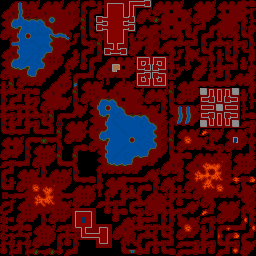
Dungeon level 4
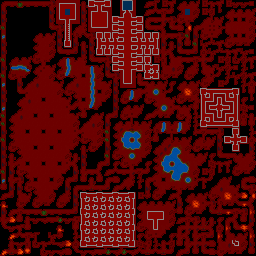
Gargoyle surface
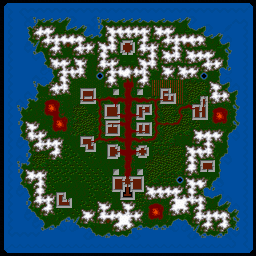
Maps from Savage Empire
Eodon Valley surface
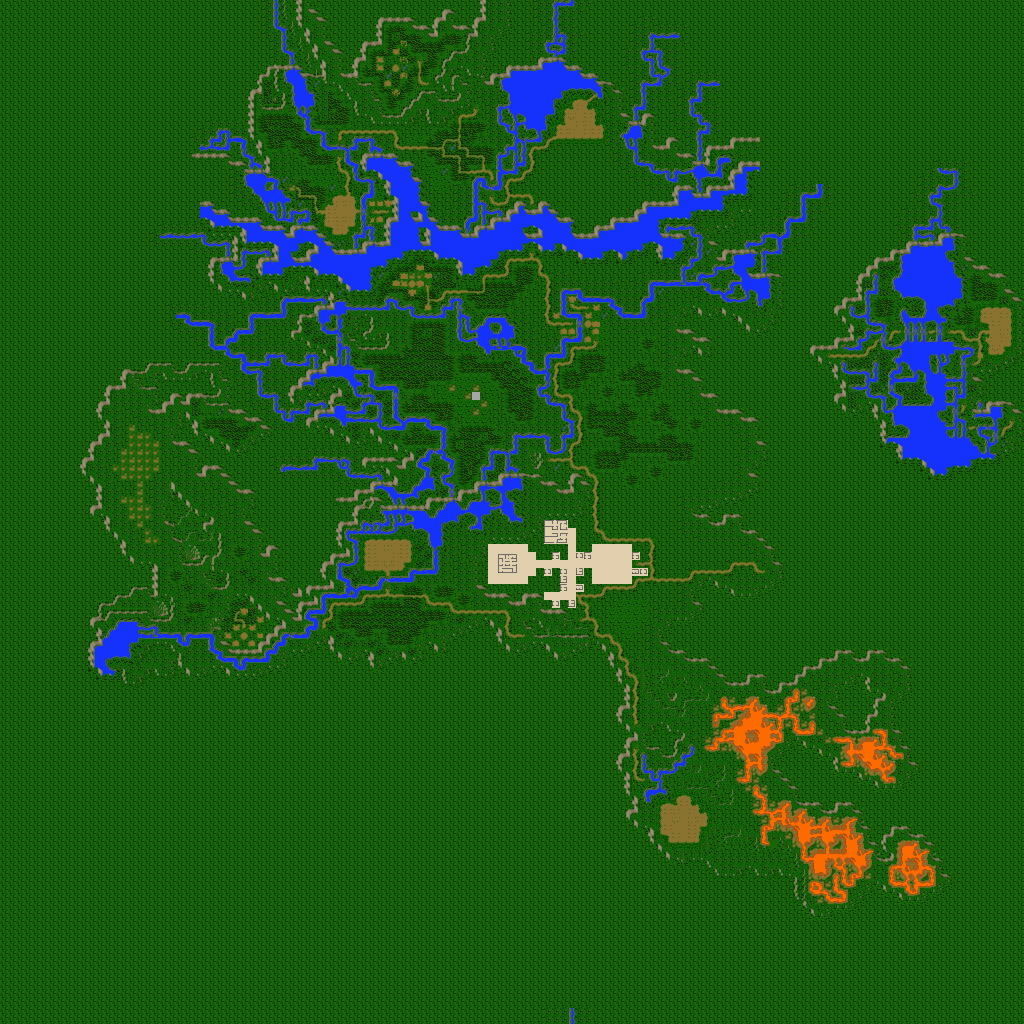
Myrmidex caves

Surface level caves
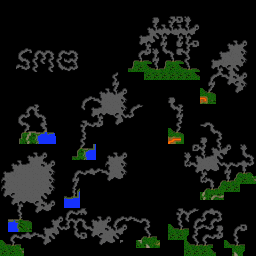
Underground city of Kotl
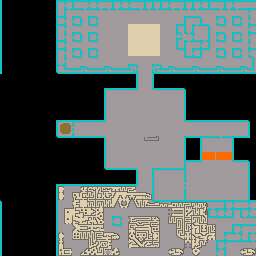
Maps from Martian Dreams
Mars surface
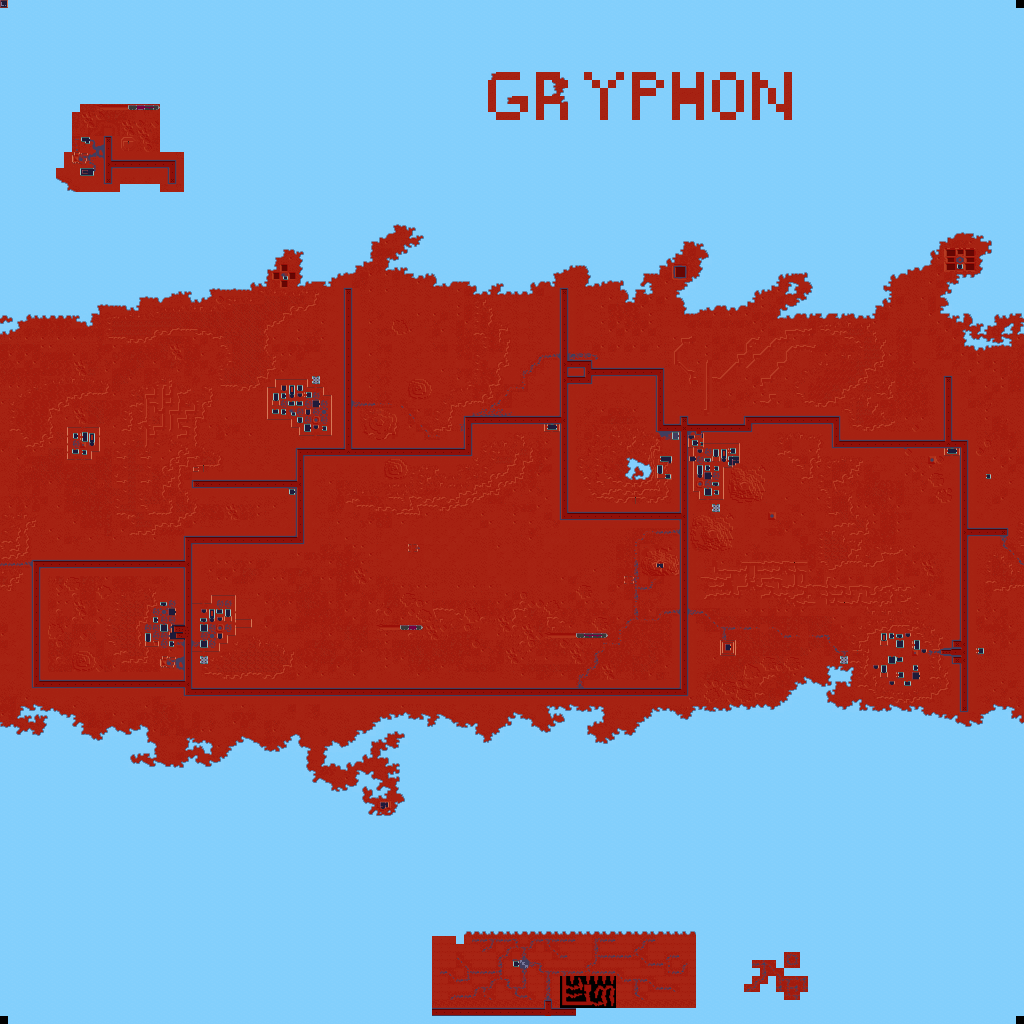
Mines
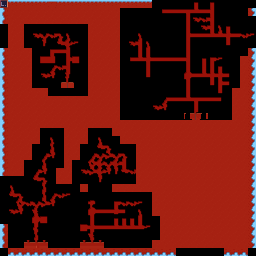
Dream World
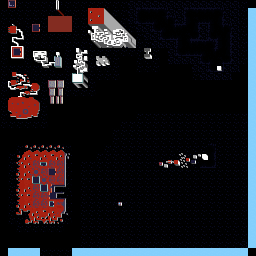
Dream World
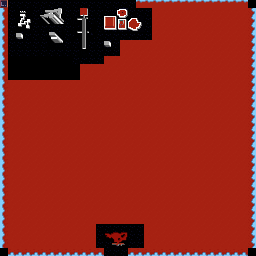
Mine and underground parts of Martian city
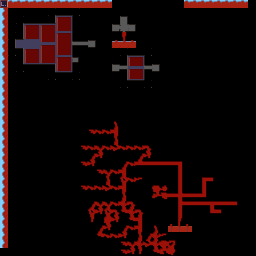
Coal mine and power plant
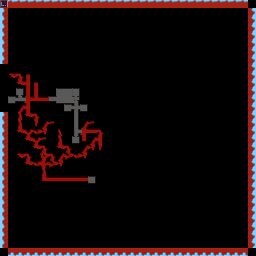
About the maps
The scale of these maps is 1 pixel per step. The data is stored in the files MAP and CHUNKS and isn't too difficult to decode, but colouring is fiddly. To colour these maps I modified the MAP and CHUNKS files to find out what tile each number corresponds to. The tiles are as follows:
Ultima VI (left), Savage Empire (centre), Martian Dreams (right)



Note that these aren't all the graphics from the games because there are two types of tile. The other tiles are object tiles, the positions and types of which are stored in the files in the SAVEGAME folder. Going to a finer scale would be rather pointless without deciphering this data. For example, you can see even at this scale that the buildings are empty.
It would be really cool to make a 1:1 scale map including all the objects, equivalent to the Eagle Eye spell. Unfortunately it would be a bit too large for your web browser - stored as a GIF file each large map would take up at least 70Mb! However, it would look nice scaled down (even better than these maps at the same scale) and it would be good to have a program that would let you scroll around and zoom into/out of the map. It would also be nice to create a census of all the characters in the games and find out the purpose (if any) of the message "Winona Ryder is a really hot babe" in Savage Empire and Martian Dreams. I may do these things someday.
Surprising stuff the maps revealed
I was surprised that the maps in Ultima VI actually form a three dimensional structure - if you scale up the small maps to the size of the large one then all the cave entrances, holes and ladders line up. The same is not true of Savage Empire and Martian Dreams. In fact, in Savage Empire the "level" isn't even related to the 3 dimensional configuration of the world.
The authors embedded hidden information into the maps as you can see - SMB (Stephen Beeman) in Savage Empire and Gryphon (Philip Brogden) in Martian Dreams. There are also some hidden areas in the poles of Mars. I don't know if these have any purpose in the game or not - I'll tell you when I've completed it.
Although the "shape of the world" is supposed to be flat in Ultima VI and Savage Empire and spherical in Martian Dreams, the true shape of each world is a torus or doughnut. If you could walk off the left you would reappear at the same place on the right, and if you could walk off the top you would reappear at the same place on the bottom. In fact you can see this effect in the Savage Empire maps: there is a river which disappears off the top and reappears on the bottom on the surface, and the rightmost walls of the underground city are on the left. This is used in Martian Dreams to create a cylindrical (okay, spherical...) world rather than a flat one.
Savage Empire uses only 4 of the 6 levels. Level 5 is empty but level 6 contains the gargoyle world straight out of Ultima VI! It doesn't quite make sense because some of the chunks (8x8 blocks of tiles) are different, but it's clearly the same map.
Links
These maps were inspired by those of Otmar Lendl. Check them out, he's got some of Ultima IV and Ultima V as well.
Mobygames entries for Ultima VI, Savage Empire and Martian Dreams.
Bartholomew Melnicki has gone much further and started plotting objects on the maps. Check it out!